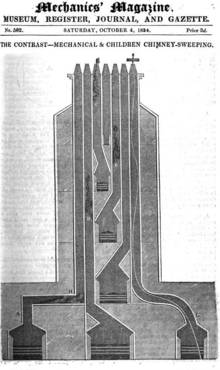- Flue
-
For other uses, see Flue (disambiguation).
A flue is a duct, pipe, or chimney for conveying exhaust gases from a fireplace, furnace, water heater, boiler, or generator to the outdoors. In the United States, they are also known as vents and for boilers as breeching for water heaters and modern furnaces. They usually operate by buoyancy, also known as the stack effect, or the combustion products may be 'induced' via a blower. As combustion products contain carbon monoxide and other dangerous compounds, proper 'draft', and admission of replacement air is imperative. Building codes, and other standards, regulate their materials, design, and installation.
Contents
Heat retention
Flues are designed to release noxious gases to the atmosphere, but they often have the disadvantage of releasing useful heat to the atmosphere. In some countries, wood fire flues are often built into a heat preserving construction within which the flue gases circulate over heat retaining bricks before release to the atmosphere. The heat retaining bricks are covered in a decorative material such as brick, tiles or stone. This flue gas circulation avoids the considerable heat loss to the chimney and outside air in conventional systems. The heat from the flue gases is absorbed quickly by the bricks and then released slowly to the house rather than the chimney. In a well insulated home, a single load fire burning for one and a half hours twice a day is enough to keep an entire home warm for a 24 hour period. In this way, less fuel is used, and noxious emissions are reduced. Sometimes, the flue incorporates a second combustion chamber where combustibles in the flue gas are burnt a second time, reducing soot, noxious emissions and increasing overall efficiency.
Other uses
Organs
The term flue is also used to define certain pipe organ pipes, or rather, their construction or style. Roman Thermaes constructed centuries ago had flues.
Boilers
Another use of the term is for the internal flues of a flued boiler.
Flue-types
Flue-types include
- Balanced flue
- Power flue
- Die flue
See also
Categories:- Fireplaces
- Heating, ventilating, and air conditioning
Wikimedia Foundation. 2010.

